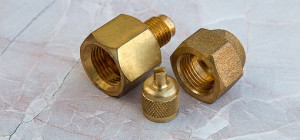 Getting the right parts is crucial to a successful repair. Start by finding your dishwasher model number (usually a combination of seemingly random numbers and letters) and punching it into an online search.
Getting the right parts is crucial to a successful repair. Start by finding your dishwasher model number (usually a combination of seemingly random numbers and letters) and punching it into an online search.
The Upgraded MFZ32863101 Pump Gasket Replacement is compatible with LG dishwashers and offers an easy DIY installation process. Its reliable performance helps prevent leakage and other issues.
Pump Gasket
This black rubber pump gasket (a sump gasket) is fitted around the edge of your dishwasher’s pump. The gasket helps to prevent leakage between the pump and filter housing. It can be replaced if it has worn out or has leaks.
This LG water inlet valve controls water flow into the dishwasher during cycle steps. Over time, mineral deposits may build up and impede the valve’s ability to close or fully open firmly. This authentic LG replacement restores dependable water control for effective cleaning and rinsing.
Before performing any maintenance on your LG dishwasher, ensure its power supply is deactivated, and the water line is disconnected. Remove the upper and lower dish racks from the appliance. Next, separate the two clips securing the bottom wash arm in position to release both ends (you may choose to remove the single screw under the arm). With caution, utilize a flathead screwdriver and pliers to uninstall the old gasket. Also, consider obtaining the necessary parts for your LG dishwasher.
Motor
The motor powers the pump and the impeller, ensuring efficient water circulation within your dishwasher. A faulty or worn-out motor could cause your machine to make loud, squealing noises during operation. This OEM replacement part is a reliable solution to restore the function of your dishwasher.
The door gasket, also known as the door seal, creates a tight fit along the perimeter of your dishwasher’s opening to prevent water and detergent from leaking during wash and rinse cycles. A damaged or missing door seal can result in a leaky dishwasher, which might expose your kitchen to water damage.
The drain hose assembly effectively drains the dishwasher after wash and rinse cycles. It’s typically installed at the rear or bottom of the unit, and it must be connected to your home’s drainage system. A clogged or broken drain hose can lead to a messy and smelly kitchen. Replace this component to ensure your LG dishwasher functions appropriately.
Door Spring
If your LG dishwasher door drops open without resistance or feels heavier when opening and closing, the tension springs on the hinge cable may be worn out. Replacing the springs will restore consistent opening and closing tension and keep the door from slamming or dropping open too quickly.
Identify the location of the springs and make a note (or even take a photo) of their position on both the front and rear brackets so that you can install the new ones in the same positions. This will ensure you get the same opening/closing tension and prevent the door from becoming crooked over time.
Before starting:
- Shut off power to the dishwasher at your home’s circuit breaker (or, in older homes, a fuse).
- Find the water supply valve in your basement or under the sink, and turn it off.
- Before reinstalling, reset the breaker or change the fuse.
- After the toe panel and access panel are reinstalled, screw them into place.
Control Panel
The control panel, or main circuit breaker panel, is the primary electrical box that houses the dishwasher’s motor and control system. If the main circuit breaker panel fails, it can prevent the dishwasher from starting or running.
Non-electrical components include the silverware basket, which neatly holds cutlery like forks during wash cycles. The door latch assembly, also called the door switch assembly, ensures that the dishwasher door is closed and latched correctly during operation. If the door latch assembly is faulty, it may fail to shut or latch the dishwasher, leading to water leaks from its opening.
The control panel also includes the water inlet valve, which supplies and drains the dishwasher with water. If the inlet valve’s screen is clogged, it may prevent water from entering the dishwasher, causing it to malfunction and flood your kitchen. Lastly, the junction box contains wires connecting to and from the other dishwasher components. The wiring schematics will call out what terminal each wire lands on and its voltage, helping to maintain safety and accuracy during installation.







